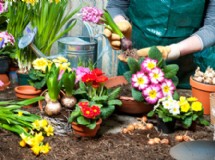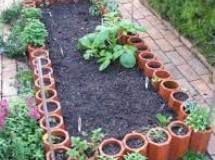- 1
Freezing is the best way to preserve vegetables.vegetables image by cherie from Fotolia.com
Start with fresh vegetables and work quickly to freeze. Freezing is the easiest method for home food preservation. Clean vegetables and cut into desired sizes. Uniform sizes are best so they will freeze and cook evenly. Blanch them: Bring them quickly to a boil, then remove them from the water after a few minutes. Plunge into ice water, drain and pack into storage containers. Many people spread the drained vegetables on cookie sheets with a little space between pieces to freeze, so they won't stick together, then transfer the frozen pieces to a large bag to pour out the desired amount as needed. Some vegetables, such as peppers, onions, carrots and celery are dense--meaning they have a low moisture content and so are less susceptible to bacteria--and do not need blanching. They can be simply cleaned, chopped and frozen. - 2
Fruits are easily frozen for later use in cooked desserts.fruit image by cherie from Fotolia.com
Freeze fruit by removing cores, stones, stems and seeds. Peel, if desired, and cut into uniform slices. Freeze berries whole. Use ascorbic acid--powdered vitamin C found on supermarket shelves in the canning section--with fruits that discolor, such as peaches, pears and apples. You may also use a tablespoon of salt, lemon juice or vinegar per quart of water. Toss fruit in liquid, then quickly drain. Any fruit may be frozen, but frozen fruits will not have the texture of fresh fruit and are best used in muffins or cobblers, pies and other desserts where they are cooked. - 3
Freeze fish fresh from the water.Dry fish on a dish in the form of a fish image by terex from Fotolia.com
Freeze meat and fish by wrapping tightly in aluminum foil with an over wrap of plastic wrap, or wrapping tightly in freezer wrap, using tape to secure the edges. If your fresh-caught fish or butchered meat has been vacuum wrapped in plastic, it can be frozen as is. Fresh venison and pork are often wrapped in freezer paper at the butcher's and can be frozen in those packages. If meat or fish is purchased in deli trays covered with plastic film, take the time to over wrap with heavy freezer paper or aluminum foil. With frozen food, it is always desirable to freeze in a form that will be easy to thaw and cook, so clean and trim first in appropriate serving sizes. - 4
Surplus cheese may be frozen for later use.Cheese. Cheddar , cream , and feta cheese on a plate image by L. Shat from Fotolia.com
Freeze eggs by breaking them into an airtight container, filling the container to 1/2-inch from the top and sealing tightly before labeling and freezing. Butter and cheese may be frozen by wrapping tightly. Milk and cream may be frozen in tightly sealed containers. Although they will lose quality and taste, they may be used in cooking. Leave at least an inch of space at the top when freezing liquids, as they will expand and may break the container. - 5
Vegetables and fruits with a high acid or sugar content are safe for home canning.canned tomatoes image by Cinderella Morff from Fotolia.com
Can vegetables and fruits with a high acid or sugar content--which means they are protected from bacterial growth--with ordinary equipment. Can tomatoes by removing skins and packing into sterilized jars. Seal them with rings and lids that have been brought to a boil and held in hot water; then process the sealed jars for 20 minutes in a boiling water bath: Use a big pot, cover the sealed jars with hot water and bring slowly to a boil before timing. You can also cook the tomatoes down before canning to save space. Jams and jellies are made by either combining with an equal amount of sugar and cooking until thick, or using a commercial pectin and additional amounts of sugar. Pickles and relishes use vinegar or salt to retard bacterial growth, and are processed in the same way. Canning jars come with complete instructions, or take the course offered online by the Center for Home Food Preservation. - 6
The green bean is an example of a low-acid vegetable that requires pressure canning.Bushel of Green Beans image by Tracey Loftis from Fotolia.com
Use pressure to can low-acid foods. This method is less common because it requires a pressure canner and some experience in using it. However, it is one alternative for those who are worried about a disrupted power supply. Vegetables and meats without enough acid to stop bacterial growth are sealed into jars, and a vacuum is created by the special equipment. Directions vary significantly, so use the instructions that come with your pressure canner. - 7
Beans, herbs, grains and spices are preserved by drying.spices in glass jars image by John Hartley from Fotolia.com
Experiment with alternative methods. There are excellent resources for home food preservation using fermentation, salt, alcohol and drying.
SHARE





































